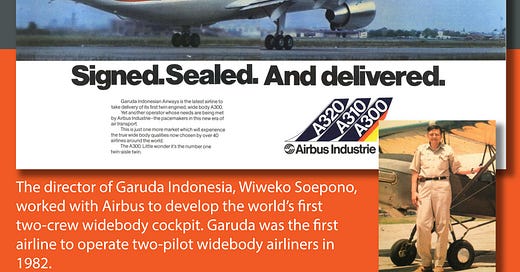Garuda Indonesia and the Airbus A300
Garuda worked with Airbus to create a two-crew cockpit for the A300; Garuda was the first to fly at two-crew widebody cockpit in commercial airline history.
This full page ad from Airbus Industrie ran in Aviation Week in 1982 when Garuda ordered the A300. What is not mentioned in this ad is that the Garuda order was significant in the history of commercial aviation as Garuda's A300s were the first widebody aircraft to have a two-pilot cockpit. Garuda was the launch customer for the A300 variant that offered airlines the option of a two-pilot cockpit or what was called the "Forward Facing Crew Cockpit" or FFCC at the time.
Appointed by President Suharto as the director of Garuda in 1968, Wiweko Soepono guided the airline from near-bankrupt with an inefficient fleet to by 1984 being the second largest airline in Asia after Japan Air Lines.
Eager to break into a market long dominated by Boeing, McDonnell Douglas and Lockheed, Airbus worked closely with airlines to tailor its aircraft to their needs as was practical. At a time when there was an often acrominous debate worldwide on going to a two-pilot cockpit for narrowbody aircraft, Soepono worked with Airbus to eliminate the flight engineer to create the first two-pilot cockpit for a widebody commercial aircraft.
For a period of time, engineers at Airbus referred to the two-pilot cockpit as the "Garuda cockpit". Today two-pilot cockpits are the standard all commercial jetliners.
Garuda took delivery of the first of it's ground-breaking A300s in January 1982 with the first two-pilot widebody commercial services in the world being flown between the Indonesia capital of Jakarta and the Sumatran city of Medan. Garuda took delivery of 9 such configured A300s and deployed them on primarily domestic routes across its vast archipelago. The average stage length of Garuda's A300 services was only 700 miles.



